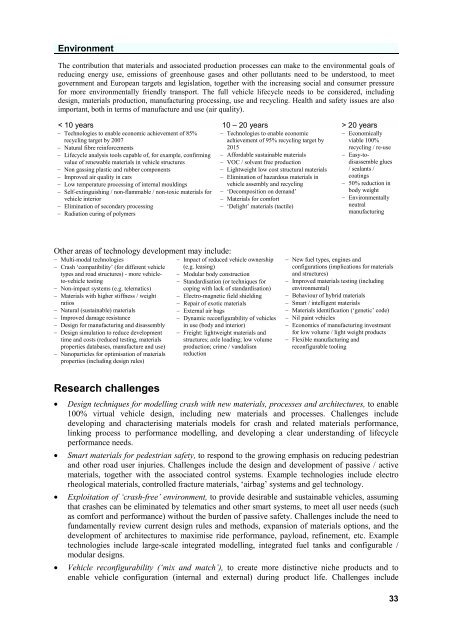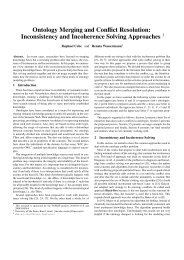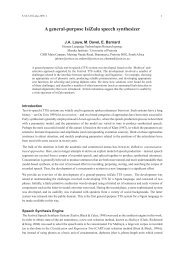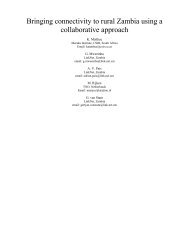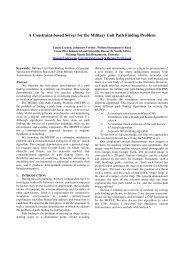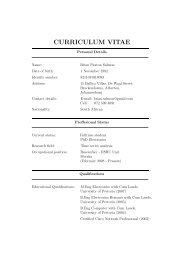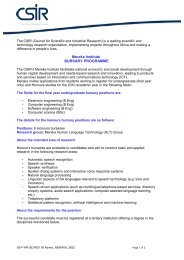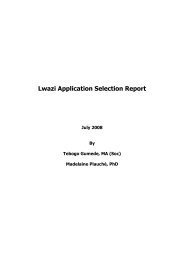Foresight Vehicle Technology Roadmap - Institute for Manufacturing
Foresight Vehicle Technology Roadmap - Institute for Manufacturing
Foresight Vehicle Technology Roadmap - Institute for Manufacturing
- No tags were found...
Create successful ePaper yourself
Turn your PDF publications into a flip-book with our unique Google optimized e-Paper software.
EnvironmentThe contribution that materials and associated production processes can make to the environmental goals ofreducing energy use, emissions of greenhouse gases and other pollutants need to be understood, to meetgovernment and European targets and legislation, together with the increasing social and consumer pressure<strong>for</strong> more environmentally friendly transport. The full vehicle lifecycle needs to be considered, includingdesign, materials production, manufacturing processing, use and recycling. Health and safety issues are alsoimportant, both in terms of manufacture and use (air quality).< 10 years 10 – 20 years > 20 years Technologies to enable economic achievement of 85%recycling target by 2007 Natural fibre rein<strong>for</strong>cements Lifecycle analysis tools capable of, <strong>for</strong> example, confirmingvalue of renewable materials in vehicle structures Non gassing plastic and rubber components Improved air quality in cars Low temperature processing of internal mouldings Self-extinguishing / non-flammable / non-toxic materials <strong>for</strong> Technologies to enable economicachievement of 95% recycling target by2015 Af<strong>for</strong>dable sustainable materials VOC / solvent free production Lightweight low cost structural materials Elimination of hazardous materials invehicle assembly and recycling ‘Decomposition on demand’ Economicallyviable 100%recycling / re-use Easy-todisassembleglues/ sealants /coatings 50% reduction inbody weightvehicle interior Materials <strong>for</strong> com<strong>for</strong>t Environmentally Elimination of secondary processing ‘Delight’ materials (tactile)neutral Radiation curing of polymersmanufacturingOther areas of technology development may include: Multi-modal technologies Crash ‘compatibility’ (<strong>for</strong> different vehicletypes and road structures) - more vehicleto-vehicletesting Non-impact systems (e.g. telematics) Materials with higher stiffness / weightratios Natural (sustainable) materials Improved damage resistance Design <strong>for</strong> manufacturing and disassembly Design simulation to reduce developmenttime and costs (reduced testing, materialsproperties databases, manufacture and use) Nanoparticles <strong>for</strong> optimisation of materialsproperties (including design rules) Impact of reduced vehicle ownership(e.g. leasing) Modular body construction Standardisation (or techniques <strong>for</strong>coping with lack of standardisation) Electro-magnetic field shielding Repair of exotic materials External air bags Dynamic reconfigurability of vehiclesin use (body and interior) Freight: lightweight materials andstructures; axle loading; low volumeproduction; crime / vandalismreduction New fuel types, engines andconfigurations (implications <strong>for</strong> materialsand structures) Improved materials testing (includingenvironmental) Behaviour of hybrid materials Smart / intelligent materials Materials identification (‘genetic’ code) Nil paint vehicles Economics of manufacturing investment<strong>for</strong> low volume / light weight products Flexible manufacturing andreconfigurable toolingResearch challengesDesign techniques <strong>for</strong> modelling crash with new materials, processes and architectures, to enable100% virtual vehicle design, including new materials and processes. Challenges includedeveloping and characterising materials models <strong>for</strong> crash and related materials per<strong>for</strong>mance,linking process to per<strong>for</strong>mance modelling, and developing a clear understanding of lifecycleper<strong>for</strong>mance needs.Smart materials <strong>for</strong> pedestrian safety, to respond to the growing emphasis on reducing pedestrianand other road user injuries. Challenges include the design and development of passive / activematerials, together with the associated control systems. Example technologies include electrorheological materials, controlled fracture materials, ‘airbag’ systems and gel technology.Exploitation of ‘crash-free’ environment, to provide desirable and sustainable vehicles, assumingthat crashes can be eliminated by telematics and other smart systems, to meet all user needs (suchas com<strong>for</strong>t and per<strong>for</strong>mance) without the burden of passive safety. Challenges include the need tofundamentally review current design rules and methods, expansion of materials options, and thedevelopment of architectures to maximise ride per<strong>for</strong>mance, payload, refinement, etc. Exampletechnologies include large-scale integrated modelling, integrated fuel tanks and configurable /modular designs.<strong>Vehicle</strong> reconfigurability (‘mix and match’), to create more distinctive niche products and toenable vehicle configuration (internal and external) during product life. Challenges include33


